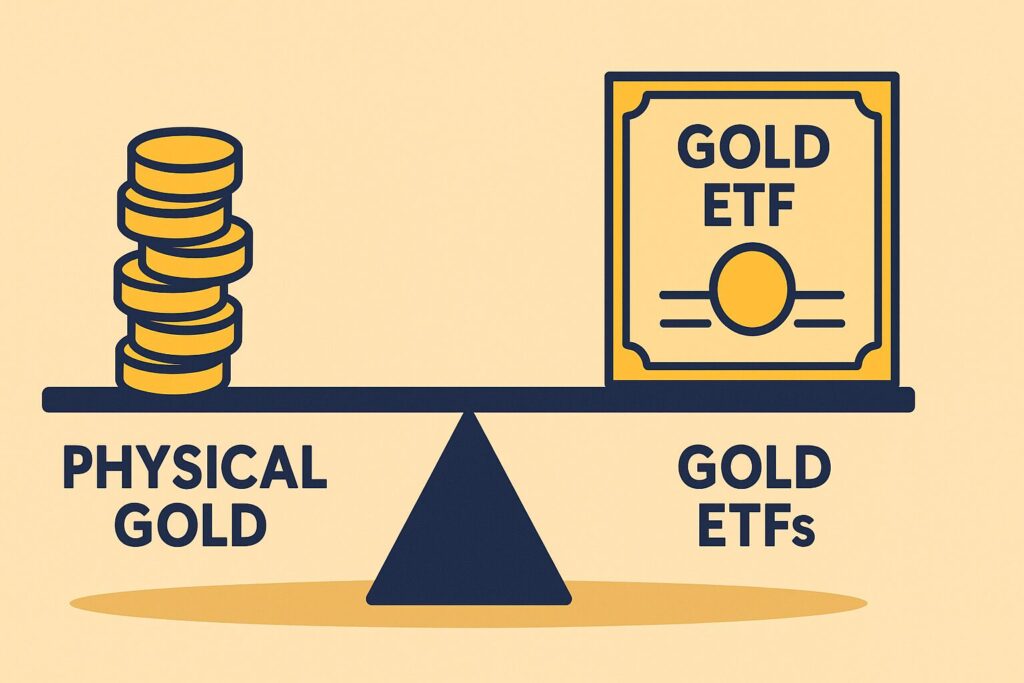
Choosing the right kind of gold for your retirement portfolio
Gold has always been seen as a safe haven in uncertain times. But when you decide to add gold to your retirement plan, you’ll face a key decision:
Should you buy physical gold—or invest in a gold exchange-traded fund (ETF)?
Both options can help protect your purchasing power, hedge against inflation, and add stability to your portfolio. But they come with different trade-offs in terms of cost, convenience, liquidity, and security.
This post will help you compare the two, in plain language, so you can confidently decide which type of gold is right for your retirement strategy.
✅ Option 1: Physical Gold (Coins, Bars, Bullion)
Pros:
- Tangible asset: You can hold it, store it, and pass it down.
- No counterparty risk: Not tied to the performance of a financial institution.
- Ultimate crisis insurance: If the financial system ever froze, physical gold would still have value.
Cons:
- Storage: You’ll need a secure place to keep it (like a safe or bank vault).
- Insurance: Storing large amounts of gold at home could be risky without added insurance.
- Harder to sell quickly: You may need to visit a dealer, verify authenticity, and accept varying buyback prices.
- Premiums and markups: You’ll usually pay more than spot price when buying (and get less when selling).
Best For: Retirees who value control, privacy, and tangible assets—and who don’t mind managing storage or security.
✅ Option 2: Gold ETFs (Exchange-Traded Funds like GLD or IAU)
Pros:
- Highly liquid: Buy and sell just like a stock—within seconds.
- Easy to manage: No safes, no security concerns, no shipping.
- Low cost: Many ETFs charge very small expense ratios.
- Tax efficiency: Easier to include in IRAs or brokerage accounts.
Cons:
- No physical ownership: You’re tracking the price of gold—you don’t hold the metal itself.
- Potential counterparty risk: Rare, but worth noting—especially during extreme market disruptions.
- Less “crisis-proof” appeal: In the event of a true financial breakdown, an ETF may not offer the same comfort as having real gold in hand.
Best For: Retirees who want simple, low-maintenance exposure to gold prices—without physical management or dealer hassles.
✅ Which One Should You Choose?
There’s no one-size-fits-all answer. Many retirees hold both—keeping some physical gold for security and investing in a gold ETF for convenience and liquidity.
Here’s a quick guide:
| If You Want… | Consider This |
|---|---|
| Easy buying/selling | Gold ETF |
| Tangible asset in your hand | Physical gold |
| To include gold in an IRA | Gold ETF |
| Crisis protection or legacy | Physical gold |
| Lower costs and more flexibility | Gold ETF |
✅ How Much Gold Should Retirees Hold?
Most financial experts recommend allocating 5–10% of your portfolio to gold. It won’t produce income, but it can help stabilize your investments when markets drop or inflation rises.
✅ The Bottom Line
Gold remains a powerful asset for protecting your retirement savings. Whether you prefer the feel of gold coins in your safe or the convenience of a gold-tracking ETF, the key is choosing the strategy that matches your lifestyle, risk tolerance, and financial goals.
Adding gold—whether physical or digital—can give you peace of mind when the world feels uncertain.
⚠️ Disclaimer
This content is for informational and educational purposes only and does not constitute financial, investment, or tax advice. Investing involves risk, including the possible loss of principal. Always consult with a licensed financial advisor before making investment decisions. The author is not a registered financial professional and does not provide personalized advice.